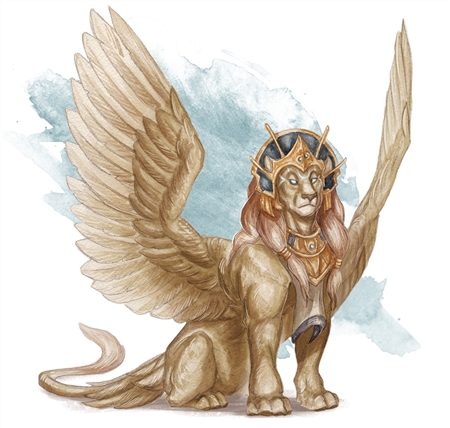 This week’s encounter is based off the sphinx, a creature from classical mythology. This mythology is best known as Greco-Roman myth in the west, but it also includes the mythologies of the cultures that existed in the Mediterranean and Asia Minor in classical antiquity—a vast period of time stretching from the 8th century BCE to the 6th century CE. Such cultures and mythology include Egypt, Persia, Phoenicia, Carthage, and a number of others.
This week’s encounter is based off the sphinx, a creature from classical mythology. This mythology is best known as Greco-Roman myth in the west, but it also includes the mythologies of the cultures that existed in the Mediterranean and Asia Minor in classical antiquity—a vast period of time stretching from the 8th century BCE to the 6th century CE. Such cultures and mythology include Egypt, Persia, Phoenicia, Carthage, and a number of others.
These encounters can be run as-is in a game set in a fantastical version of ancient Earth, or they can be adapted to fit the plane of Theros, described in the upcoming sourcebook Mythic Odysseys of Theros.
Sphinxes in Theros
On the plane of Theros, sphinxes are much the same as they are in the rest of Dungeons and Dragons. They are clever riddlers that enjoy toying with mortals. Moreover, they often wield the power of the gods themselves, and may be tasked by the gods to guard items or locations of great power or sanctity.
The sphinx in this encounter is a gynosphinx named Kalakia. She was once a mighty warrior that battled monsters for the thrill of it, and she bears many scars as signs of her years of combat, including a long gash that begins on her left temple, crosses her left eye and her leonine muzzle, and terminates at her right jaw. She was tasked by one of the gods with defending a legendary relic in this dungeon, and commanded to not let any intruders through unless she was bested.
Kalakia stayed true to this command for something approaching one thousand years, but time has made her bored and weary. She hasn’t had anyone but the boorish manticores that have made their nest in the unprotected parts of this dungeon for company for the past hundred years, and she’s desperate for entertainment. As soon as the adventures enter her domain, she traps them and forces them to answer her riddles—if only to inject some amusement into her life. The entertainment boosts her mood immensely, and she ultimately figures that any adventurers that successfully solve one of her riddles has technically “bested” her, thus fulfilling her obligation.
Scaling this Encounter
Since this encounter primarily tests the adventurers’ social skills and their players’ riddle-solving skills, this encounter is suitable for characters of any level. However, there’s a good chance that combat will occur if the characters answer a riddle incorrectly. In that case, you can make this encounter more suitable for characters of higher or lower levels by changing the creatures in this encounter based on the levels listed below. These creatures are other denizens of the dungeon, and though the sphinx may not be friendly with them, they have agreed not to harm one another.
- Tier 1 (2nd level): 1 gynosphinx, 5 imps
- Tier 2 (5th level; as written): 1 gynosphinx, 10 manticores
- Tier 3 (11th level): 1 androsphinx, 10 chimeras (each chimera has a different colored dragon head); set this encounter in a cavernous chamber that is at least 1000 feet long and 200 feet high.
- Tier 4 (17th level): 1 empyrean, 5 devas, 3 planetars; set this encounter in a demiplane that is at least 2000 feet long and 500 feet high.
This is just the beginning, though. You can use the D&D Beyond Encounter Builder to further tailor this encounter to suit your party’s size and strength. If you’re playing with parties that are at the strong end of their tier, err on the side of increasing the numbers of the creatures in that tier, rather than pitting them against a higher-tier encounter.
Social Encounter: Impatient Riddles
This encounter is suitable for characters of any level, if you follow the scaling guidelines.
The characters enter a new room in a tomb or dungeon and suddenly find themselves in the presence of a majestic sphinx. Read or paraphrase the following:
You enter a room at the base of a short staircase, with tall walls on either side of you. After ascending the stairs, you emerge into a sandy arena, dimly lit by torches burning with blue flame. The door slams shut behind you, and iron bars slide into place in front of it. Before you stands a majestic sphinx, her long and unruly mane decorated with splendid golden finery. A raucous wave of cheering and jeering erupts around you, and you see nearly a dozen manticores sitting in amphitheater-style seating all around the room.
“Welcome, tomb-robbers,” the sphinx purrs. “I am Kalakia. Behind me is the treasure you seek, yet I have been tasked by the gods to not relinquish it unless I am bested.” She yawns loudly and crosses her paws. “But I have stood vigil here for an eon, and I grow bored. Perhaps being bested in a game of riddles would be suitable to release me from my charge?”
Kalakia stamps a paw and the blue flames illuminating this room grow brighter, revealing innumerable bas relief carvings all along the walls of this chamber. The carvings depict gods, mythic locales, monsters, spells, and artifacts wielded by mighty heroes.
Behind this gynosphinx is the door to the tomb’s inner sanctum—which is barred just like the door the characters entered through. The ten manticores in this chamber have wild beards and unruly tempers. These boorish creatures have been Kalakia’s only source of entertainment for years, and the manticores are likewise eager for fresh faces to break up their boredom.
If attacked, Kalakia bares her fangs and shows no mercy. Once she kills one adventurer, she turns to the rest, with fire in her eyes, and asks, “Do not provoke me, mortals. I am far easier to best at riddles.”
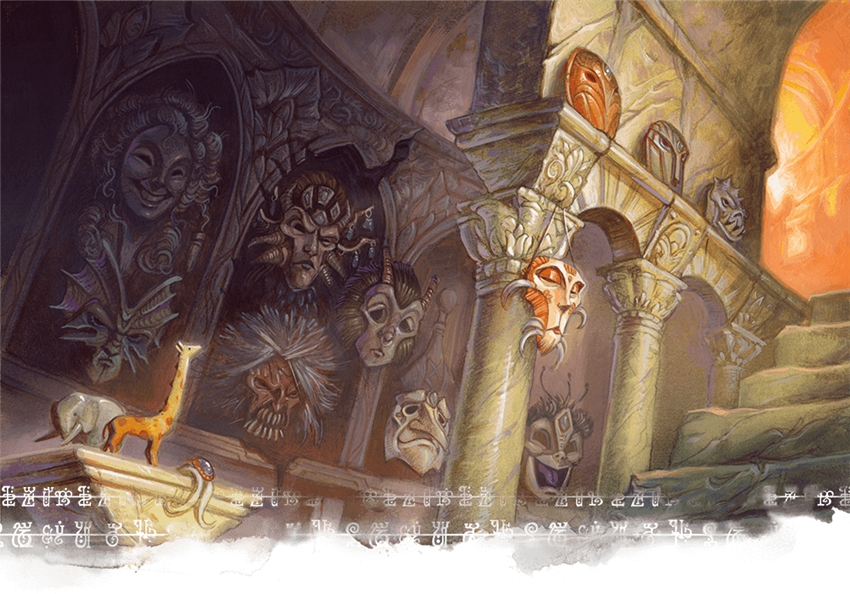
Kalakia’s Riddles
Kalakia has five riddles she wishes to ask of the adventurers. She only allows the party to answer each riddle once; if someone confidently blurts out an answer, she takes it as to attempt to answer the riddle. If a character answers incorrectly, some of the manticores in the stands attack (see “Incorrect Guesses,” below). If a character answers correctly, she gleefully assures them of their success and grants them a reward (see “Correct Guesses,” below).
If the characters don’t guess any of the riddles correctly, she asks the first riddle again and starts over, granting them another chance at solving her puzzle.
The riddles are:
- A magic beyond mortal hands am I, a tool of divine knowledge that reveals myths and tales forgotten to time. What am I? (Answer: legend lore)
- The servant of the sun am I, for my wings draw his chariot across the sky. Friend of heroes, I flit through countless legends. (Answer: pegasi)
- An incantation of the silver huntress (“verdant huntress,” in Theros) am I, a light that pierces the form of deceit, and kills in silence. What am I? (Answer: moonbeam)
- The city at the end of all roads am I, yet I may only be reached by water. One guard stands watch at my gates, yet six eyes keep careful vigil. What am I? (Answer: the Underworld)
- A weapon that made by mortals in homage of the gods am I, a spear with the power to split the sky. My lowborn cousins are thrown by athletes and warriors alike, but I am crafted from more magical stock. What am I? (Answer: javelin of lightning)
Thinking Up Clues
A character can make an Intelligence check to think of a piece of information that might help them solve the riddle. The DC of this check is variable; succeeding on a check with a higher DC grants more esoteric information. If multiple characters make Intelligence checks with similar results, reveal hints with lower DCs, until they have received all the clues that are available to them with the results of that check.
If you want to force the players to rely more on their own riddle-solving skills rather than their characters’ in-world knowledge, consider removing the DC 25 results, since those results explicitly reveal the answer to the riddle. Alternatively, consider putting these results further out of reach by increasing the DC of those results by 5 (if the characters are 11th level or higher) or by 10 (if the characters are 17th level or higher).
The chamber’s walls are covered with innumerable bas relief carvings depicting gods, monsters, spells, magic items, and mythical locations that the characters can inspect to help them answer the riddle.
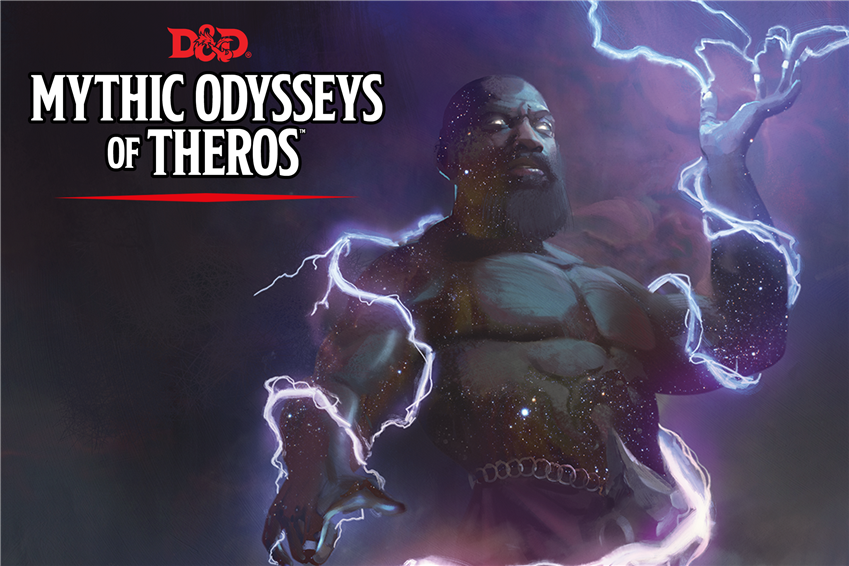
Riddle 1: “Legend Lore”
- DC 10: It sounds like this riddle is describing a spell.
- DC 15: This spell is probably a divination spell, likely a very powerful one that reveals information that has passed out of mortal memory.
- DC 25: You recall that clerics who worship gods of knowledge are often granted a spell called legend lore, which cryptically reveals lore that has been lost to time.
Riddle 2: “Pegasi”
- DC 10: It sounds like this riddle is describing a magical creature—possibly one with real wings.
- DC 20: Judging by its description, the creature in this riddle has probably appeared in both tales of great heroes and myths about the gods.
- DC 25: You know that the chariot of the god Helios (Heliod, if playing in Theros) is drawn by winged horses. These pegasi draw the sun from east to west, and their kin have often served as steeds for mythic heroes.
Riddle 3: “Moonbeam”
- DC 10: The phenomenon described this riddle sounds like a spell with the power to kill.
- DC 15: The silver huntress mentioned here is probably the goddess Artemis, who is associated with the moon. (Alternatively, if you’re playing in Theros: The verdant huntress mentioned here is probably the goddess Nylea, who is often worshipped by druids of the Circle of the Moon.)
- DC 25: You know that the spell moonbeam calls down silvery light that kills silently and reveals the true forms of shapeshifters.
Riddle 4: “The Underworld”
- DC 10: Something about this riddle feels supernatural, like the place it’s describing isn’t in the world of mortals.
- DC 15: The phrase about one guard with six eyes could mean that the guardian has three heads, each with one pair of eyes.
- DC 25: You know that the final destination of all souls is the Underworld, whose gates are guarded by the three-headed dog Cerberus, and to reach it one must cross the River Styx.
Riddle 5: “Javelin of Lightning”
- DC 10: This is likely a magic item, perhaps a throwing weapon enchanted with the power of lightning.
- DC 15: Whatever this is, it was wielded by both warriors and athletes. Javelins are weapons used in both war and sport.
- DC 25: You have heard stories of javelins that transform into bolts of lightning, created to emulate the lightning bolts thrown by the great god Zeus (Keranos, if playing in Theros). These are called javelins of lightning.
Incorrect Guesses
If a character answers a riddle incorrectly, Kalakia says, “Oh, that’s not quite it” (or something similar) and the manticores start to taunt and jeer the characters. One of them even swoops down and attacks the characters, roaring “Enough highbrow rubbish! Give us blood!” The manticores roar in approval and Kalakia makes a halfhearted attempt to restrain them. She swipes one paw lethargically and wearily mumbles, “Stop, wait, come back.”
The manticore has no desire to kill, only to entertain its brethren and prove that it is stronger than the characters. If it reduces a character to 0 hit points with a melee attack, it checks its blow and merely knocks the character out. The manticore retreats to the stands to lick its wounds after being reduced to half its hit point maximum.
After each incorrect guess, one additional manticore swoops down (so the second incorrect guess provokes two manticores to attack, and so forth). Manticores at full health attack first, but even wounded ones start attacking as the crowd gets more and more riled up.
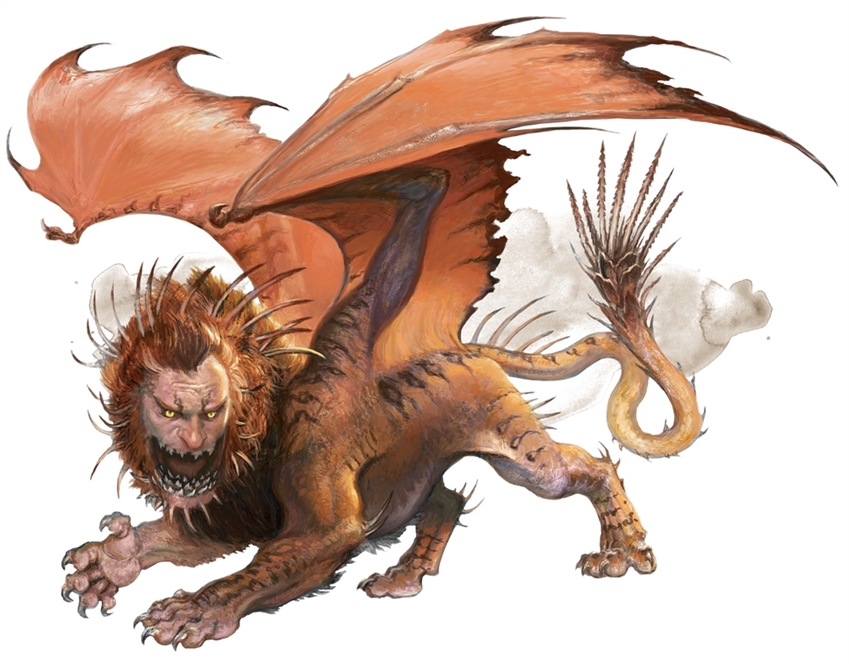
Correct Guesses
Once the characters solve one riddle, the sphinx yawns and flicks her paw, causing the doors to unlock. She grumbles and says, “You’re free to go… but I am terribly bored. I’ve guarded this door for so long, and you’re the first entertainment I’ve seen in gods-forsaken eons. I have some trinkets collected here. Stay a while longer and riddle with me some more?”
If the characters want to stay, she has up to four magic items that award them with for more successful guesses. Once they’ve solved one riddle, however, they only have one chance to get each riddle right. Kalakia won’t return to the start of her list of five riddles anymore after this point. These further rewards can be magic items of your choice. Some examples include:
Alternatively, you could have her offer her supernatural power as a reward, casting spells like remove curse, dispel magic, or legend lore instead of granting a magic item.
Conclusion
Once the characters have correctly guessed at least one of Kalakia’s riddles, they are free to go. Whatever lies beyond the sphinx’s chamber is up to you. If the characters fail to guess any of the riddles and are all knocked out in this chamber, the sphinx may eject them from the dungeon or devour them mercilessly, depending on the tone and lethality of your game.
For more adventures in a mythical setting inspired by Greek mythology and the Magic: the Gathering plane of Theros, preorder Mythic Odysseys of Theros on the D&D Beyond Marketplace, available digitally on June 2nd, 2020! If you're one of the first people to preorder Mythic Odysseys of Theros at your local game store, you'll get a code for 50% off the digital edition on D&D Beyond!
Create A Brand-New Adventurer Acquire New Powers and Adventures Browse All Your D&D Content
Did you like this encounter? Check out the encounters in the Encounter of the Week series. You can also pick up the adventures I've written on the DMs Guild, such as The Temple of Shattered Minds, a suspenseful eldritch mystery with a mind flayer villain. My most recent adventures are included in the Platinum Bestseller Encounters in Avernus, a collection of over 60 unique encounters created by the Guild Adepts, which can be used to enhance your campaign in Avernus or elsewhere in the Nine Hells. Also check out the Platinum Bestseller Tactical Maps: Adventure Atlas, a collection of 88 unique encounters created by the Guild Adepts, which can be paired with the beautiful poster battlemaps in Tactical Maps Reincarnated.
 James Haeck is the lead writer for D&D Beyond, the co-author of Waterdeep: Dragon Heist, Baldur's Gate: Descent into Avernus, and the Critical Role Explorer's Guide to Wildemount, a member of the Guild Adepts, and a freelance writer for Wizards of the Coast, the D&D Adventurers League, and other RPG companies. He lives in Seattle, Washington with his fiancée Hannah and their animal companions Mei and Marzipan. You can find him wasting time on Twitter at @jamesjhaeck.
James Haeck is the lead writer for D&D Beyond, the co-author of Waterdeep: Dragon Heist, Baldur's Gate: Descent into Avernus, and the Critical Role Explorer's Guide to Wildemount, a member of the Guild Adepts, and a freelance writer for Wizards of the Coast, the D&D Adventurers League, and other RPG companies. He lives in Seattle, Washington with his fiancée Hannah and their animal companions Mei and Marzipan. You can find him wasting time on Twitter at @jamesjhaeck.
Also, check out the latest episode of Silver & Steel, a new D&D stream starring DM Jasmine "ThatBronzeGirl" Bhullar, Todd and Meagan Kenreck, Lauren Urban, and B. Dave Walters.








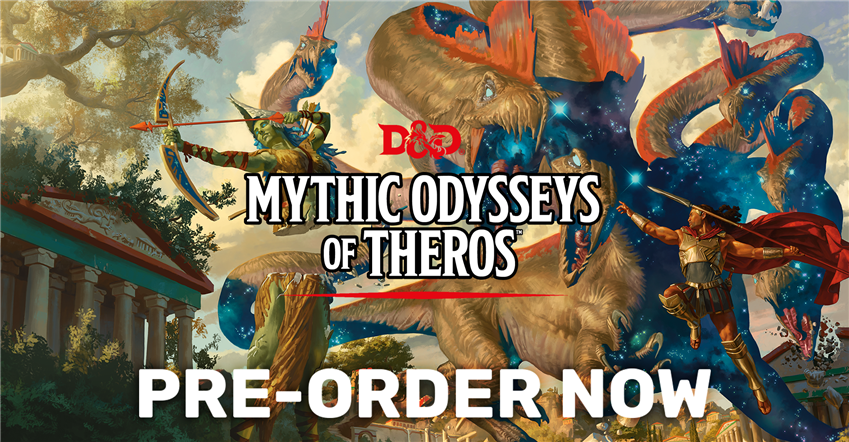
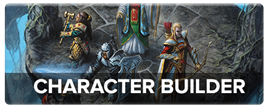
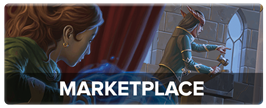
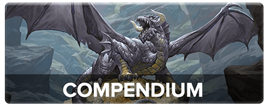
-
View User Profile
-
Send Message
Posted May 11, 2020Nice! Love these! First!
-
View User Profile
-
Send Message
Posted May 11, 2020Love the article and the riddles, but my players wouldn't know any of these. also, there were a few [tooltip not found]s.
-
View User Profile
-
Send Message
Posted May 11, 2020Yeah mine either.
-
View User Profile
-
Send Message
Posted May 11, 2020Maybe if the riddles were not dnd related but stuff that also exists in real life. Love this though.
-
View User Profile
-
Send Message
Posted May 11, 2020Yeah. Especially for new players who have never even read a rulebooks.
I really liked this post, though I have a few questions: first off is why would a gynosphinx be with some imps? And why would an Androshpinx be with some chimeras?
But it was still very good.
-
View User Profile
-
Send Message
Posted May 11, 2020They're simply other denizens of the dungeon that agree to leave each other alone for their own mutual benefit. Most sphinxes are lawful neutral creatures, so they tend not to attack evildoers unless they're particularly chaotic, or they directly harm the sphinx itself.
-
View User Profile
-
Send Message
Posted May 11, 2020Ok. Any examples of riddled for newbies who know almost nothing about DnD?
-
View User Profile
-
Send Message
Posted May 11, 2020I think the sphinx riddles in Assassin's Creed: Odyssey are great for players who want more "common sense" riddles.
-
View User Profile
-
Send Message
Posted May 11, 2020Cool idea for a more brainy type of "bossfight"
-
View User Profile
-
Send Message
Posted May 11, 2020They're pretty good riddles. Thanks James!
-
View User Profile
-
Send Message
Posted May 11, 2020I see a Willy Wonka reference ^_^
<3
-
View User Profile
-
Send Message
Posted May 11, 2020Where? Is it with what the manticore says?
-
View User Profile
-
Send Message
Posted May 11, 2020It's not an exact quote but it reminds strongly of Wonka's "Stop. Don't. Come back" when Mike Teavee runs into the Wonkavision set and Wonka makes no meaningful effort to stop him.
-
View User Profile
-
Send Message
Posted May 11, 2020This is more nitpicky on my part, but I noticed that the text says that the door slams shut behind them without ever mentioning that they walked through a door. However, that's just a small detail. Overall this encounter is amazing, and I can't wait for the Theros book to come out!
-
View User Profile
-
Send Message
Posted May 12, 2020I Love the riddle Part! Could you make create more of those because I can never think of good riddles like that.
-
View User Profile
-
Send Message
Posted May 14, 2020You use BCE and then AD. Is that on purpose? One is religious and one is not.
-
View User Profile
-
Send Message
Posted May 14, 2020Oh, just got my wires crossed. I've amended that to BCE and CE.
-
View User Profile
-
Send Message
Posted May 15, 2020I really like these riddles and want to use them. But I have had a riddle-situation encounter before with one of my players and she admitted to straight-up cheating to find the answers on Google and when I copy/pasted any of the riddles you provided it naturally pointed to this page by default. So unfortunately I cannot use any of these. Because she's a cheating brat that cannot be trusted, I would have to make my own, but I love how you incorporated spells into the riddles and made them unique, I can probably try something like that if something like that happens again!
-
View User Profile
-
Send Message
Posted May 15, 2020banana ;-;
-
View User Profile
-
Send Message
Posted May 16, 2020I actually love riddles that are D&D specific when playing with new players. They key, however, is that the DM needs to start introducing some of these concepts a session or two (or more) before the encounters come up. So, have a powerful Cleric cast Legend Lore and explain a bit about what they are doing - the more inquisitive your players are, the more familiar they will be with the concept. You can even have the Cleric use exact phrasing from the riddle which might jolt their memory when they hear it again later. The same is true for the other riddles, but they might need to be approached differently. Maybe they come across another adventuring party who is looking for (or maybe just found) the javelin of lightning.
These concepts are great tools, but need to be tailored to your own specific situations. Thanks for the effort in putting these things together!